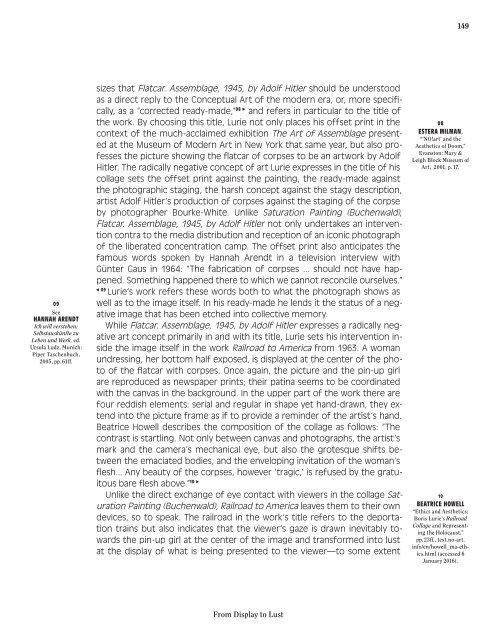The Art of
Katalog_Boris-Lurie_English
Katalog_Boris-Lurie_English
Create successful ePaper yourself
Turn your PDF publications into a flip-book with our unique Google optimized e-Paper software.
149<br />
09<br />
See<br />
HANNAH ARENDT<br />
Ich will verstehen:<br />
Selbstauskünfte zu<br />
Leben und Werk, ed.<br />
Ursula Ludz, Munich:<br />
Piper Taschenbuch,<br />
2005, pp. 61ff.<br />
sizes that Flatcar. Assemblage, 1945, by Adolf Hitler should be understood<br />
as a direct reply to the Conceptual <strong>Art</strong> <strong>of</strong> the modern era, or, more specifically,<br />
as a “corrected ready-made,” 08 and refers in particular to the title <strong>of</strong><br />
the work. By choosing this title, Lurie not only places his <strong>of</strong>fset print in the<br />
context <strong>of</strong> the much-acclaimed exhibition <strong>The</strong> <strong>Art</strong> <strong>of</strong> Assemblage presented<br />
at the Museum <strong>of</strong> Modern <strong>Art</strong> in New York that same year, but also pr<strong>of</strong>esses<br />
the picture showing the flatcar <strong>of</strong> corpses to be an artwork by Adolf<br />
Hitler. <strong>The</strong> radically negative concept <strong>of</strong> art Lurie expresses in the title <strong>of</strong> his<br />
collage sets the <strong>of</strong>fset print against the painting, the ready-made against<br />
the photographic staging, the harsh concept against the stagy description,<br />
artist Adolf Hitler‘s production <strong>of</strong> corpses against the staging <strong>of</strong> the corpse<br />
by photographer Bourke-White. Unlike Saturation Painting (Buchenwald),<br />
Flatcar. Assemblage, 1945, by Adolf Hitler not only undertakes an intervention<br />
contra to the media distribution and reception <strong>of</strong> an iconic photograph<br />
<strong>of</strong> the liberated concentration camp. <strong>The</strong> <strong>of</strong>fset print also anticipates the<br />
famous words spoken by Hannah Arendt in a television interview with<br />
Günter Gaus in 1964: “<strong>The</strong> fabrication <strong>of</strong> corpses ... should not have happened.<br />
Something happened there to which we cannot reconcile ourselves.”<br />
09<br />
Lurie‘s work refers these words both to what the photograph shows as<br />
well as to the image itself. In his ready-made he lends it the status <strong>of</strong> a negative<br />
image that has been etched into collective memory.<br />
While Flatcar. Assemblage, 1945, by Adolf Hitler expresses a radically negative<br />
art concept primarily in and with its title, Lurie sets his intervention inside<br />
the image itself in the work Railroad to America from 1963. A woman<br />
undressing, her bottom half exposed, is displayed at the center <strong>of</strong> the photo<br />
<strong>of</strong> the flatcar with corpses. Once again, the picture and the pin-up girl<br />
are reproduced as newspaper prints; their patina seems to be coordinated<br />
with the canvas in the background. In the upper part <strong>of</strong> the work there are<br />
four reddish elements: serial and regular in shape yet hand-drawn, they extend<br />
into the picture frame as if to provide a reminder <strong>of</strong> the artist‘s hand.<br />
Beatrice Howell describes the composition <strong>of</strong> the collage as follows: “<strong>The</strong><br />
contrast is startling. Not only between canvas and photographs, the artist’s<br />
mark and the camera’s mechanical eye, but also the grotesque shifts between<br />
the emaciated bodies, and the enveloping invitation <strong>of</strong> the woman’s<br />
flesh... Any beauty <strong>of</strong> the corpses, however ‘tragic,’ is refused by the gratuitous<br />
bare flesh above.” 10<br />
Unlike the direct exchange <strong>of</strong> eye contact with viewers in the collage Saturation<br />
Painting (Buchenwald), Railroad to America leaves them to their own<br />
devices, so to speak. <strong>The</strong> railroad in the work‘s title refers to the deportation<br />
trains but also indicates that the viewer‘s gaze is drawn inevitably towards<br />
the pin-up girl at the center <strong>of</strong> the image and transformed into lust<br />
at the display <strong>of</strong> what is being presented to the viewer—to some extent<br />
08<br />
ESTERA MILMAN,<br />
“‘NO!art’ and the<br />
Aesthetics <strong>of</strong> Doom,”<br />
Evanston: Mary &<br />
Leigh Block Museum <strong>of</strong><br />
<strong>Art</strong>, 2001, p. 17.<br />
10<br />
BEATRICE HOWELL<br />
“Ethics and Aesthetics:<br />
Boris Lurie’s Railroad<br />
Collage and Representing<br />
the Holocaust,”<br />
pp. 23ff., text.no-art.<br />
info/en/howell_ma-ethics.html<br />
(accessed 6<br />
January 2016).<br />
From Display to Lust



